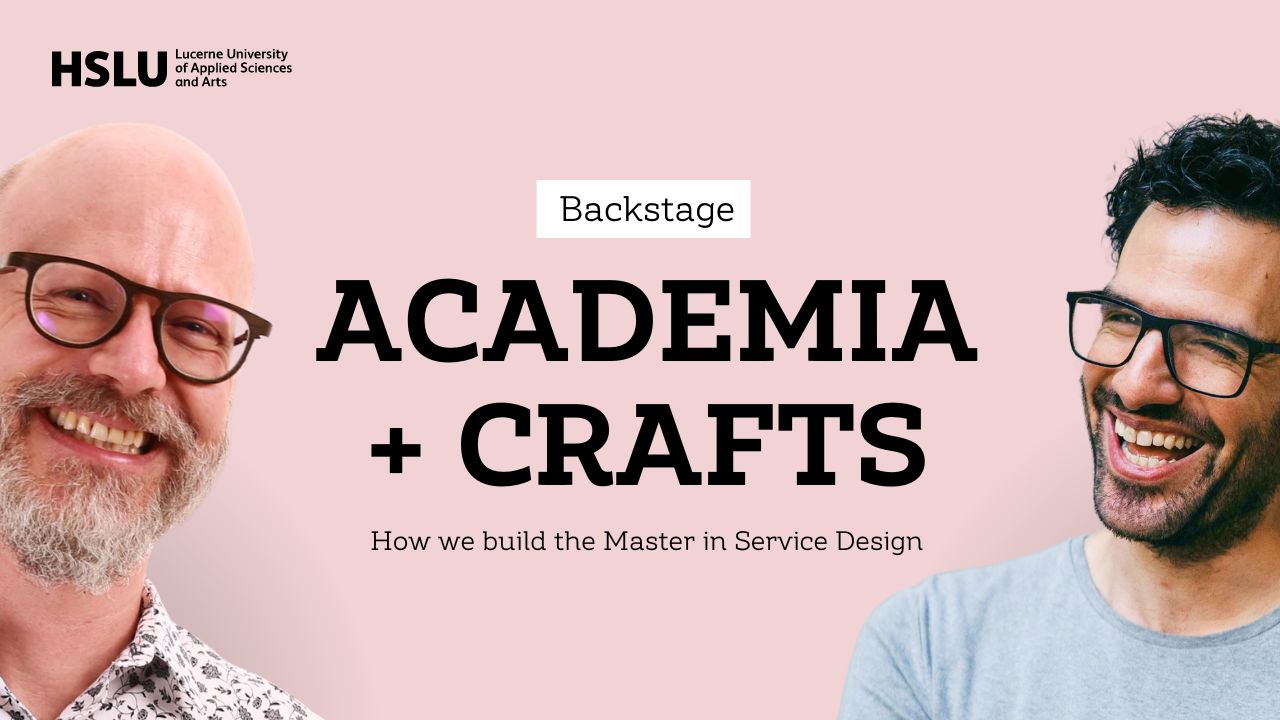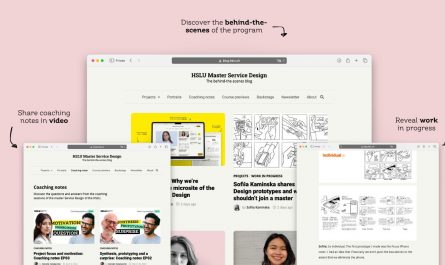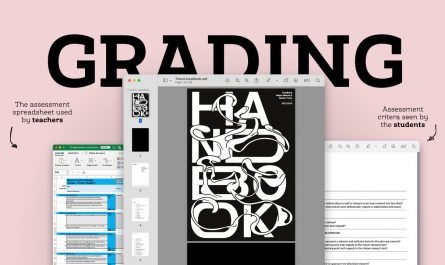During the semester break faculty member redesign key parts of their program.
In this conversation Andy Polaine and Daniele Catalanotto share a few of the new rituals their bringing in the Service Design program to ensure there is a good balance between academia and crafts.
In summary
Here an overview of some of these new rituals:
- No conversation without an artefact
- Artefacts not only prototypes
- Use repetition to build the crafts muscle
- Reflect on each class by producing shitty ideas
Watch the whole video
Video transcript
This transcript was fully generated using Descript. The transcript wasn’t corrected. Which means it can be pretty creative, funny or wrong at moments.
Introduction
Daniele: So Andy, here we are again. And this time I’m very curious about one aspect that we talk a lot in the backstage between us:
How can we help students within an academic world to still be very crafts oriented?
And we’re trying a few new things for this next semester. And I’d like you to share a few of these elements with us.
Andy: We are indeed.
Balancing Theory and Craft in Education
Andy: And I think sometimes we want to inject a lot of theory into our teaching because we want to make sure it’s rigorous, intellectually rigorous, and it’s a, it’s a master’s degree. But there’s a lot of that around it too. And when people are working, they actually also need to know the craft of service design and the things they actually need to do.
So there’s a few different rituals that we decided on. One of them is this idea of.
The Importance of Artifacts in Service Design
Andy: No Conversations Without an Artifact. This comes from a few people like Alan Chochinov from the School of Visual Arts and John Kolko.
They both talk about this. I found it very [00:01:00] useful if you’re having ideas and service design can be a little bit abstract anyway, sometimes to fix it in some kind of artifact, either a schematic, a storyboard then imagine someone using this thing, what’s the story? What would they be using?
Those are the touch points, who would they be interacting with and all that stuff and to fix that down and have some kind of artifact to talk to because Otherwise you can just talk forever with ideas and they’re these kind of platonic ideals and seem great in your head. And it’s only when you start actually trying to make them tangible, do you realize all the problems and it just makes it so much better to have a conversation about a thing.
rather than just an idea.
Daniele (2): And there is one word that I love in what you say, which is the word artifact, which is much broader than just, it has to be a
Andy (2): Yeah.
Daniele (2): And I think this is a very strong thing for us, especially in service design work. In the early stages, maybe you just have a few photographs of
Andy (2): Yeah.
Daniele (2): that you think are interesting and a mood board of service experiences kind of a key change that we also try [00:02:00] to bring which is lower the expectation of it is to make something and that’s anything at least that it’s as long as it’s not just words on a piece of paper that’s what we expect and I think this is a very
Andy (2): Yeah.
Practical Exercises and Ideation Techniques
Andy (2): There’s an exercise that industrial designers classically do. They probably do it in other disciplines too, where, as industrial design students, your professor comes in with a vacuum cleaner or something and says, okay, Take this apart and understand how it was made. Which bits are injection molded, which bits have been welded together and all of that stuff.
And I think it’s really useful to do with services too. And because we all know, I think instinctively, we have the sense of that was a really great service and that’s a really bad one. But we need to pull them apart to understand why exactly is that great or not. And so that thing where you can say one of the artifacts can be, yeah, I’ve had this experience at this service.
I’m going to break it apart and really have a look at it and understand how it works and what makes that good. That can also be an artifact, too.
Daniele (2): Absolutely. And there is another thing that we’re going to try out [00:03:00] this semester, which is all about turning kind of the class that people have about service design into something. Can you maybe tell us a little bit more about that?
Andy (2): So in order to get people into the ideation phase really quickly, even though they’re probably going to, throw away a lot of those ideas, at the end of every class that we’ve got, where we teach for a day, We’re going to get people to come up with 10 shitty ideas. So you and I know, we’ve had this conversation lots of times about this idea of A hundred shitty ideas is a really good way of forcing yourself to think beyond the most obvious ones.
And so by the end of the semester they will have, they’ll have more than a hundred shitty ideas. And So at the end of the class. We’re going to get you to come up with 10 shitty ideas, reacting to whatever you’ve learned in the class and what does that inspire? What can you think of?
Maybe they, they just get thrown away, but maybe there’s one or two of those that you think, Oh, actually there’s a thing and I can continue and develop that over the course of the semester. So the [00:04:00] idea is to get you thinking tangibly again, straight away.
Repetition and Iteration in Learning
Daniele (2): And there is a beauty in that, it reminds me of how in art schools, you learn to draw, when you take the students, put them in front of the Mona Lisa and say, draw it, and then the next day it’s basically now draw it again. And then the next day you draw it again and you draw it again, you draw it again.
And then once you have done that, you go to the next drawer, to the next painting and then say, start over. And I think there is a value into that repetition side, where it’s not just. Build 100 ideas once but also this every time you can use that muscle and you can push it a bit further.
Andy (2): A thing I’ve learned over the years of teaching is. The students that do really well do their project several times in the course of their masters or bachelors. I’ve seen this over and over again. I saw someone in Australia once and they did this animation and it was really beautiful.
It was great. And, but she wasn’t happy with it and, but she had done it in enough time to go, I’m actually going to go, I’m going to make this all over again. Of course, the final thing was [00:05:00] fantastic. It won awards and stuff. And I think that’s really important that your final piece of work that you end up presenting is not the first draft, right?
Cause that can often end up being the case. So our aim is to try and force the students to not do that.
Daniele (2): And I think that’s the tension that we are in, and it’s a positive
Andy (2): Yeah. Yeah.
Daniele (2): academic world where there is theoretical there is a rigor in theory and and academic view. But we are also in this special thing in Switzerland, which is these practical universities where it’s very professional, and so bringing in the craft side as something that repeats itself I think is something that is definitely very
Andy (2): Yeah. I think what that gets back to is also. Kind of what design thinking slightly broke apart, which is, there is thinking that happens up front before you start designing. But actually, I would argue, two thirds of the thinking is happening while you are doing and [00:06:00] making. And you can get caught in a loop of thinking and thinking, and I’ll just get my idea perfect before I start anything.
And of course, it’s really just a kind of procrastination, that. And actually, it’s much better once you start making something. Oh, now I’ve started making it, I realize it’s, my idea is not this, it’s that, and that would be so much better. And that doesn’t come until you actually start making, until you actually start doing.
Adapting to Changing Contexts
Daniele (2): As a conclusion I feel that these examples that we just shared here show also a bit of the mindset that we have in the backstage of the program and how we set it up, we are not making the version dot five of the program. We’re rather making the version 15. 15 now and we slowly, even I think during the semester, we’ll make an update, which will be 15.
Andy (2): Yeah.
Daniele (2): I feel it, it’s also nice that our students see that we’re tinkering with all of these things as they do with their own projects.
Andy (2): Absolutely. I think one of the things there is also the context changes over time, right? So I started this program, you were one of the students couple of years [00:07:00] afterwards, I think back in 2009, back then it was very new. Service design was very new. Design thinking had not happened as a sort of big thing.
We hadn’t had the whole kind of digital product design thing happen. Things were very different back then and people coming in from different areas. And so what that has meant is, as the kinds of students are coming, they come in with different experiences, different expectations. The environment that they’re coming from is different to what it was even a year ago and where they’re going into is going to be different as well.
And I think that’s why it’s important to keep reacting to that and changing and shifting.
Daniele (2): So
Conclusion and question
Daniele (2): Thanks a lot, Andy, for that conversation. inspiring to spend some time with you. My question to our community is, How do you keep a balance between the craft side and the daily business stuff?
Do you have certain habits that you use like? 10 shitty ideas after a meeting.
Andy (2): I’m very interested to know any tips or tricks people have to [00:08:00] make service design tangible from, instead of this kind of abstract thing. What things do you do to really lock down an idea into an artifact that people can have a conversation about?
The backstage of the backstage
Daniele (2): I was thinking that it would be nice to have the bloopers at the end of this one with, beep,
Andy (2): I’ve got so many.
Daniele (2): be fun.
Andy (2): I’ve got so many. any tips or tricks people have to turn. Oh man. Fuck. Let’s try again. have that to, Jesus.
Daniele (2): Can you maybe tell us a little bit more about that?
Andy (2): I don’t know what to think anymore. What’s the thing you’re asking me about there?
Daniele (2): It’s the 10 shitty ideas that at the end of
Andy (2): Oh yeah.


